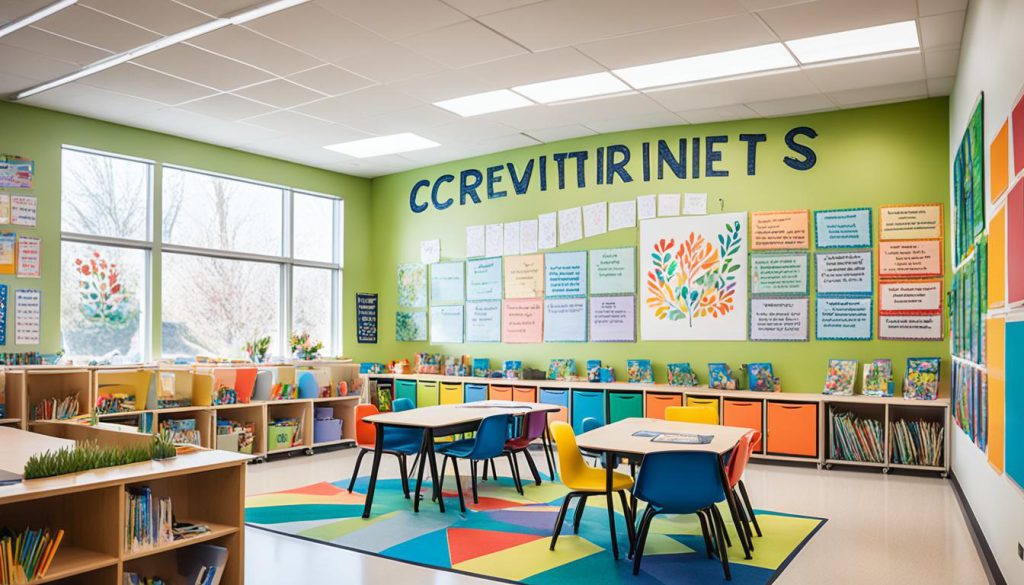Did you know that good teaching in early childhood matters a lot? High-quality programs help kids do better in school and in life. They gain social skills and have a strong start.
To make sure early childhood education is top-notch, we need to follow important guidelines. By using well-planned strategies, teachers can make learning fun and meaningful. They can meet the needs of every child.
This article talks about the Framework for Effective Practice by the National Center on Early Childhood Development, Teaching, and Learning. We will look at six key parts of this framework. You’ll get tips and advice on how to use these ideas in schools.
Key Takeaways:
- Using best practices in early education sets kids up for success.
- The Framework for Effective Practice offers a detailed plan for quality education.
- Considering things like interaction, the learning environment, and curriculum is important.
- We should focus on creating welcoming learning places, use proven curriculum, and serve every child’s unique needs.
- It’s very important to support fairness and include everyone to ensure high-quality education for all kids.
Interaction and Environments: Nurturing and Engaging Learning Spaces
The first element targets creating nurturing, responsive learning spaces. It aims at fostering positive social interactions and curiosity. Making learning a loved activity is essential.
Children thrive when learning spaces are both nurturing and engaging. They feel safe and eager to learn in such environments. These spaces suit their varied needs and interests, helping each child actively engage.
Promoting Social and Emotional Development
Educators enhance social and emotional growth using several strategies. They encourage peer interactions and teamwork. This boosts children’s social skills and helps them form connections.
Effective interactions involve listening and responding to children’s needs. They also mean validating their feelings and guiding them. Such a space boosts children’s self-esteem, and emotional skills.
Stimulating environments are key to sparking curiosity. They offer books, art supplies, and toys that inspire. This encourages children to explore and be creative.
Creating Equitable and Inclusive Environments
Equitable environments offer all children chances to succeed. Educators work to make spaces inclusive and culturally responsive. Every child should feel valued and respected.
Diversity is integrated through books, displays, and activities. This helps kids learn about various cultures and perspectives. Celebrating diversity fosters a welcoming environment for everyone.
Interactions and environments are the core of effective teaching. They nurture and engage children in supportive ways. This creates a space where learning, growth, and development flourish.

Curriculum: Implementing Research-Based Practices
In early childhood education, the curriculum is key for children’s growth and learning. The Framework for Effective Practice shows the importance of using research-based curriculum and teaching practices. This approach helps teachers make learning fun and effective, meeting the needs and goals of kids.
Choosing curriculum materials that are based on research is crucial. These resources use well-tested methods and ideas, making them work well in teaching. Teachers can use these proven materials to give kids the best learning experiences.
Research-based materials help in all areas of a child’s growth. This includes their thinking, feelings, body, and language skills. They offer clear advice for teachers on the best teaching methods and activities. This way, kids can learn and grow in many ways.
These materials are also flexible and open to all. They let teachers change lessons to fit every child’s needs. Such customization helps teachers support each child better, making sure they are involved and learning.

Using these research-backed ways of teaching helps schools keep getting better. Teachers stay up-to-date and improve how they teach. They also learn more about how kids grow and the best ways to teach.
By following research-based methods, teachers make classrooms better for kids. They use proven strategies to help kids learn and develop in different areas. This mix of research and teaching ensures kids get a top-notch education, readying them for the future.
Individualized Support: Meeting the Needs of Every Child
The fourth element of effective practice is about custom teaching for every child. It knows each child is unique with different ways of learning. Tailoring lessons to their strengths and challenges is key.
Individualized support is crucial in education. It lets teachers give specific attention and help that spurs growth in kids. By knowing and meeting their varied needs, teachers make sure all kids do well in school, with friends, and in life.
“Every child is a unique individual, and it is our responsibility as educators to provide them with the support and resources they need to succeed.”
Educators use individual support to make learning fit for everyone. They check on each student’s progress and change how they teach accordingly. This includes knowing what each student is good at and what they need help with.
Adapting Instruction for Diverse Learners
Individualized support is more than just teaching in different ways. It includes many strategies to help each child learn best. These strategies can be:
- Targeted help for specific skills or areas.
- Different materials for various ways of learning.
- Adjusted tasks and tests so everyone can do them.
- Working with special education pros for students who need it.
To support each child, teachers must really understand them. This means strong ties with students and their families for better insight. Together, they pin down what each child needs to do well.
With individualized support, teachers guide every child to their full potential. By meeting each one’s unique needs, they make learning fair and open for all. This helps every student find success.

Equity-Focused Practices: Creating Inclusive Learning Environments
Creating inclusive places to learn is very important in early childhood education. The Framework for Effective Practice tells us equity-focused practices are key. They help fight inequality and bias in schools. This lets all kids have the chance to learn and grow in a positive way.
Equity-focused practices make sure every child gets to access good education equally. They aim to knock down barriers. This helps honor and support every child’s unique needs and background.
An inclusive learning environment helps kids feel they belong. This boosts their academic, social, and emotional growth. Teachers bring in many different views and traditions into lessons. They also build strong, positive relationships and respect different cultures.
With equity-focused practices, schools become places where kids feel safe and supported. They learn to value different cultures. This prepares them to be part of a world full of diversity. It helps build a fair society for the future.

